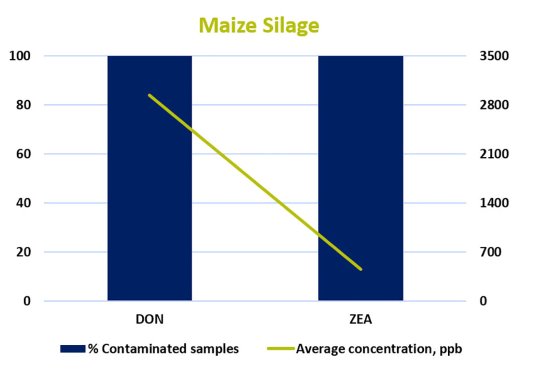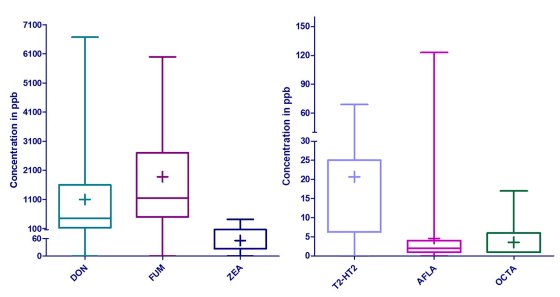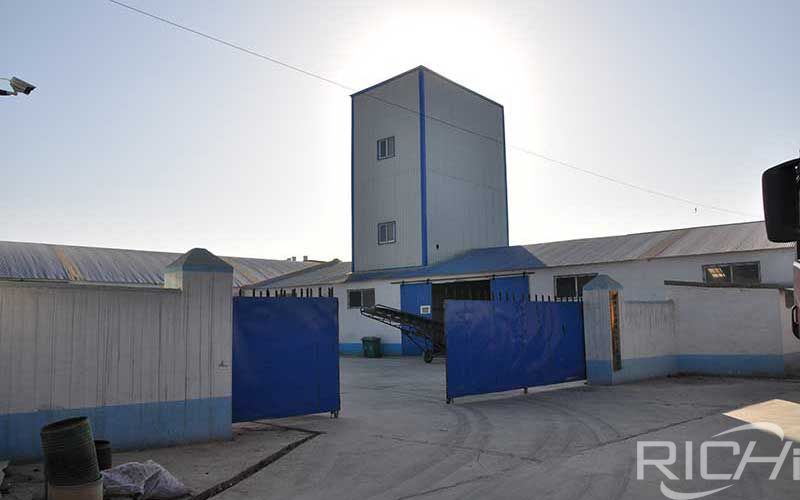
This is where you find all our press releases and news articles.
1. Know the risk factors in the ration
Dairy cows’ diets are remarkably diverse and can include forage, grains, silage, water and byproducts. This diversity requires both nutritional and microbial knowledge to support feed safety. Bacteria, yeasts and moulds can proliferate in various feedstuffs threatening the nutritional quality and compromising the palatability of the feed as well as the food produced. For example, in both anaerobic and especially aerobic conditions, yeast can quickly dominate. As yeast convert sugars into water and carbon dioxide, they increase the pH, allowing harmful bacteria to proliferate. In the meantime, yeast negatively impacts both palatability and the nutritional value of the feed ingredient. Additionally, under aerobic conditions (which occur in the top layer of a silage) moulds can develop and potentially produce mycotoxins harmful to the health and performance of cows.
2. Know the risk factors in the farm environment
In addition to ingredients in the ration, conditions on the dairy farm and in the silage bunks can compromise feed safety. For example, air leaking into the silo can allow harmful bacteria such as E. coli, Salmonella and Listeria to survive, presenting a risk for listeriosis in animals. This condition can lead to septicemia and impaired animal performance. These foodborne bacteria can also make their way into food consumed by people, potentially posing a threat to human health. Other farm factors that can influence feed safety include extreme weather, insect/bird damage, the presence of fungus, and farm management and feeding speed
3. Practice biosecurity and good hygiene
On a dairy farm, faecal material and slurry in pastures are two paths for bacteria to make its way into the food chain. Good biosecurity practices can help protect against pathogen spread on the dairy farm. A few biosecurity practices examples include: requiring workers to change clothing/boots, erecting fencing to keep animals confined, minimising fence line contact with neighbouring animals, and knowing the herd history of any incoming animals.
4. Consider the source
High humidity, temperature and un-seasonal rains during crop growth and harvesting can increase mould prevalence and mycotoxin risk in the dairy diet. For example, weather conditions in 2019, ranging from the heat waves in parts of Europe to excessive rains in the US, have contributed to higher prevalence and concentrations of various mycotoxins in ruminant feed. Knowing the origin of various ingredients and the regional weather conditions during crop growth and storage, can help to evaluate risk for common microbes and mycotoxins. The 2019 Global Crop Assessment conducted by Trouw Nutrition provides data on growing conditions in 38 nations around the globe.
Figure 1 - Contamination percentages and average concentrations of various mycotoxins in silages.
Figure 1 - Maize Silage
Figure 1 - Grass Sliage
5. Measure and evaluate to make timely decisions
Both the presence and prevalence of microbiological and mycotoxin threats in the ration should be assessed. The 2019 Global Crop Assessment (Figure 1) shows the prevalence of common mycotoxins in 564 silages (maize and grass) collected from around the globe. When compared to practical limits, the data can suggest specific toxicity concerns. For example, Figure 2 shows that levels for Aflatoxin were at the threshold limit of 5ppb, while concentration levels of Deoxynivalenol (DON) were more than twice the practical limits. Rapid analysis of mycotoxins in raw ingredients makes it possible for dairy farmers to make changes in ingredient sourcing or introduce interventions to support feed safety – such as the introduction of hygiene aids on the farm.
Figure 2 - Potential toxicity in ruminant feed
6. Employ an integrated approach to manage feed safety and mitigate risk
Feed safety demands an integrated approach that considers the entire food production chain. Crops in the field, feed processing at the mill, biosecurity measures during feed transport, and safe storage on the farm all contribute to feed safety. Globalisation and climate change pose additional challenges when it comes to protecting the integrity of feed. With an eye on an increasingly global feed environment, Trouw Nutrition has developed an integrated Feed Safety programme providing a holistic approach to feed management. The NutriOpt Mycotoxin Adviser connects to a global database providing real-time analysis of raw materials and finished feeds and allows farmers to compare their feed ingredients and compound feed with samples collected around the globe. Additional technologies support feed hygiene and production at the mill; and during storage.
It should never be assumed that the presence of mycotoxins in feedstuffs will be addressed further downstream in the production chain. For example, Aflatoxin B1 (AFB1) biotransformation results in a toxic metabolite, AFM1, excreted in milk and this by-product can resist heating processes and pasteurisation of milk. Identifying and addressing the threat as soon as possible is essential to protecting the safety and integrity of food such as milk. As the theme of 2020 World Food Safety Day reminds us, “Food safety is everyone’s business.”
1. Indonesia 3-5T/H Ruminant Animal Feed Pellet Line

Cattle Feed Mill Plant Project Case
2. South Africa 10T/H Cattle Feed Pellet Line
Having the right mix of reliable, high-quality pellet machine and pelletizing systems and expert support is essential to your success. Watch how our end-to-end feed pellet plant solutions have helped our customers optimize their performance.
Our customized and future-proofed turnkey pellet plant solutions is designed with you at the core. From vision to reality and beyond, our team stays connected with yours. Giving you peace-of-mind with an expert at your side.

At RICHI, we go beyond project completion. With RICHI Servicee, we’re your dedicated partners in success. Count on us for expert guidance, minimal downtime, and optimized productivity. Choose RICHI for unmatched service and support.



Meet global product demands and quality standards with industry-leading pellet plant design, engineering, equipment, and construction services for pellet processors.


Your Partner Beyond Project Completion
2000+ cases
RICHI is the leading designer, manufacturer and builder of pellet plants in the world, completing over 2000 projects in 140 countries across 6 continents.
Read More
Increase plant productivity, profitability, and safety by integrating high quality equipment into your pellet production line. Over the years, RICHI has become China's top pellet equipment manufacturer. At the same time, RICHI has established valuable partnerships with the world's leading component and raw material manufacturers to bring you the best there is in technology, automation, and efficiency in pelleting plant machinery.

For nearly 30 years, RICHI has been providing best-in-class pellet plant equipment and services to clients across a variety of industries, sizes, and needs. We pride ourselves on the knowledge and skill that each team member possesses – from our technical sales team to our process design engineers. You can count on RICHI Machinery to take your operation to the next level of innovation, quality, and success.
Need help with your pellet manufacturing plant project? Contact us today.
ANIMAL FEED
BIOMASS
WOOD
ORGANIC FERTILIZER
AQUA FEED
CAT LITTER
MUNICIPAL WASTE RECYCLING
SPECIAL PELLET PRODUCTION
RICHI Machinery continues to deliver world class pellet mill equipment, pellet plant engineering and project solutions that add value to our customers in the animal feed, wood waste, agriculture waste, organic fertilizer, cat litter and special pellet products industries. Throughout the years, we RICHI Machinery have built strong brand, becoming industry-leading pellet machine manufacturer. We value integrity, promise quality, and prioritize your success.
Learn MoreWith our expert team, we precisely implement your process engineering requirements in pellet mill and pelletizing plant systems. No matter which industry you’re in – we understand your needs and deliver solutions that meet the highest standards.
At RICHI, quality comes first. Our pellet making machine and related pellet line equipment undergo rigorous quality controls to ensure they meet the highest standards. Rely on products that are durable, safe, and efficient.
With decades of experience in pellet machine and pellet production line production, we have earned a reputation as a trusted partner in various industries. Our expertise allows us to cover a wide range of applications.
Not only do we offer premium pelleting equipment, but we are also experts at designing, building, installing, and maintaining facilities from the ground up. Our expertise is within pellt plant process design, discovering the most efficient, productive, and profitable way to handle your materials in an end-to-end cycle.

Keeping in touch with us is an effective way to solve all your problems. If you have any needs or questions, please leave your contact information, then RICHI technical consultants will send design, quotation, videos to your mailbox. You can also contact us directly via WhatsApp: +86 13838389622
Copyright©2015-2024 by HENAN RICHI MACHINERY CO., LTD. All rights reserved.